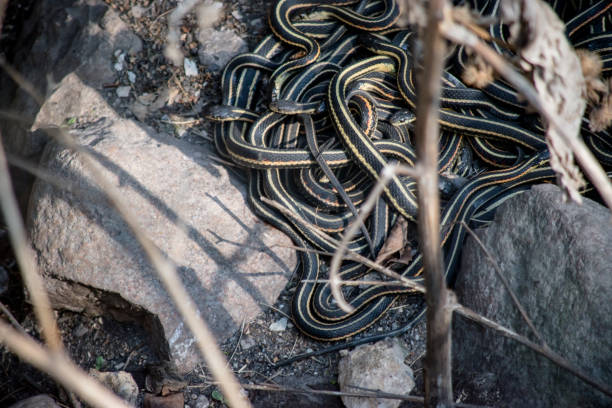ANIMAL: Red-Sided Garter Snake Thamnophis parietalis Type of Animal: Colubrid Habitat: Woodlands, grasslands, farmland, hillsides, marshland, stream/pond sides, meadows, grassy knolls, forests, fields, lawns, wetlands, streams, ponds, prairies, mountainous areas Location(s): E British Columbia, Alberta, Saskatchewan, CS NW Territories, S Manitoba, far SW Ontario, Montana, extreme CN & E Wyoming, far NE Colorado, Dakotas, Nebraska, Kansas, Oklahoma (except for panhandle), extreme NE Texas bordering Oklahoma, extreme NW Arkansas, W & N Missouri, most of Iowa, & most of Minnesota (not in areas bordering Wisconsin) Appearance: Thin snakes w/ noticeable red sides, dark green to black w/ 3 yellow stripes, vertical red and/or orange bars, some black patterning, large eyes Food/Diet: Slugs, worms (especially earthworms), leeches, lizards, amphibians, eggs, small fish, small mammals, insects, smaller snakes, crayfish, young birds, spiders, millipedes, centipedes Status in Wild: Stable Conservation: Breeding in zoos & nature centers Lifestyle: Groups of 10-100 (especially in dens), sometimes even thousands. Additional Info: Called: Male Female Young-Snakelet Group-Knot/Bed Weight: Male- 4 oz Female- 5.3 oz Gestation: 2-3 months Life Span: 4-6 years Body Length: Male- 1.3-2 ft Female- 2.5-3 ft Young- 8 in Tail Length: Male- 5.16-7.2 in Female- 9-10.8 in Main predators are large fish, turtles, bullfrogs, birds, larger snakes (most snakes), & carnivorous/omnivorous mammals. These snakes ovoviviparous, in which eggs hatch inside mom’s body & born live. Females give birth to between 5-95 young. Sexually mature at 1.5 years old. Hibernates in winter in sizeable groups. Has excellent sense of smell/sight. They’re diurnal & sometimes, crepuscular (active at dawn & dusk). Breeds in spring & fall. Breed in mating balls, which can have up to 25 males per 1 or 2 females. Fun Fact(s): Usually, males & females produce different pheromones but some males w/ high estrogen levels secrete pheromone that females have to attract other males, fooling other males. These snakes more likely to discharge musk rather than bite if cornered. Long thought nonvenomous but actually produce very mild neurotoxic venom, which is chewed into wounds since they have enlarged teeth in back of mouth. Bites primarily harmless but may cause minor swelling/itching. Toxins in saliva used on prey.

